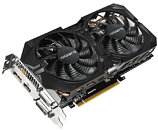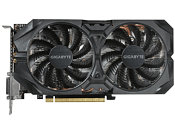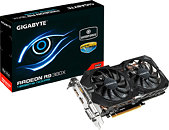Tuesday, February 16th 2016

GIGABYTE Unveils Radeon R9 380X WindForce 2X Graphics Card
GIGABYTE started its Radeon R9 380X graphics card lineup with just one model, the R9 380X G1.Gaming (GV-R938XG1 GAMING-4GD). The company now launched its variant, which sticks to AMD reference clock speeds, the R9 380X WindForce 2X (GV-R938XWF2-4GD). Based on a custom-design PCB by GIGABYTE, the card features the company's WindForce 2X cooling solution, which features an aluminium fin-stack heatsink that uses three copper heat pipes to draw heat directly from the GPU die; dissipating it with a pair of 90 mm spinners. The cooler features 0 dBA idle, it completely shuts the fans off when the GPU is idling.
Based on the 28 nm "Antigua" silicon, the Radeon R9 380X features 2,048 stream processors, 128 TMUs, 32 ROPs, and a 256-bit wide GDDR5 memory interface, holding 4 GB of memory. GIGABYTE's card sticks to AMD reference clock speeds of 970 MHz core, and 5.70 GHz (GDDR5-effective) memory. The card draws power from a single 8-pin PCIe power connector. Display outputs include two dual-link DVI, and one each of DisplayPort 1.2a and HDMI 1.4a connectors. The card will be priced at US $230.
Based on the 28 nm "Antigua" silicon, the Radeon R9 380X features 2,048 stream processors, 128 TMUs, 32 ROPs, and a 256-bit wide GDDR5 memory interface, holding 4 GB of memory. GIGABYTE's card sticks to AMD reference clock speeds of 970 MHz core, and 5.70 GHz (GDDR5-effective) memory. The card draws power from a single 8-pin PCIe power connector. Display outputs include two dual-link DVI, and one each of DisplayPort 1.2a and HDMI 1.4a connectors. The card will be priced at US $230.





26 Comments on GIGABYTE Unveils Radeon R9 380X WindForce 2X Graphics Card
EDIT: GTX 960 is already taken cared, next is GTX 970 - www.hardocp.com/article/2016/02/15/rise_tomb_raider_video_card_performance_review/4#.VsL1B_l97IU
Even the "new" Grenada chips differ from Hawaii in ability to perform at higher frequencies.
SP: 2048
ROPs:32
TMU: 128
Silicon: 28nm
380X
SP 2048
ROPs: 32
TMU: 128
Silicon: 28nm
The only difference is the memory, being 256bit wide instead of the 7970's 384bit wide interface. The 380X's memory is clocked higher, thus has a higher "effective" speed, but a lower available bandwidth.
Obviously its a different architecture (hence the 50W TDP reduction), but for all intent and purpose, they're the same.
Specs are the same, but they are far from the same card. Although they do perform similarly.
The answer is "when they have something new", which they will whenever Polaris comes out. And even then it'll be kept around, doing odd-jobs.
Antigua/Tonga:
Tahiti:
Also two different architectures. Tahiti is first-gen GCN, Tonga/Antigua is third-gen GCN. What you're doing is like calling Haswell the same chip as Ivy Bridge, just because some specs look the same.
A while back (2015) my hypothesis was 1440p would be mainstream basically supplanting 1080p for many daily/casual gamers over the next two years. As of late I see so many new UltraHD monitors (TN) it has me considering 1440p is already tenuous, and in a year Ultra HD monitors will appear so often in the same price bracket that why pay for only a 1440p. At which point many of the cards in use today will become dated as the 28nm holding pattern has made them.
This card should be like $140 tops
THIS
"They are the same because they gimped its bus width. If it had the same bus width as 7970, it would be a lot better due to compression and better tessellation engine. It's a technological "marvel" that means little to the end user since they don't really benefit anything from it."
www.hardware.fr/news/13842/amd-devoile-gpu-milieu-gamme-tonga.html
GTX960 vs 380X = 380x wins hands down, & the 380x is here in Australia $50 more then GTX960 & more ram...
Like btarunr said the chips are not the same, The 970 is a hell of a lot more $$$ here in AUS its $500 & 380X is $370 not a fair comparison as far as price vs perf goes.